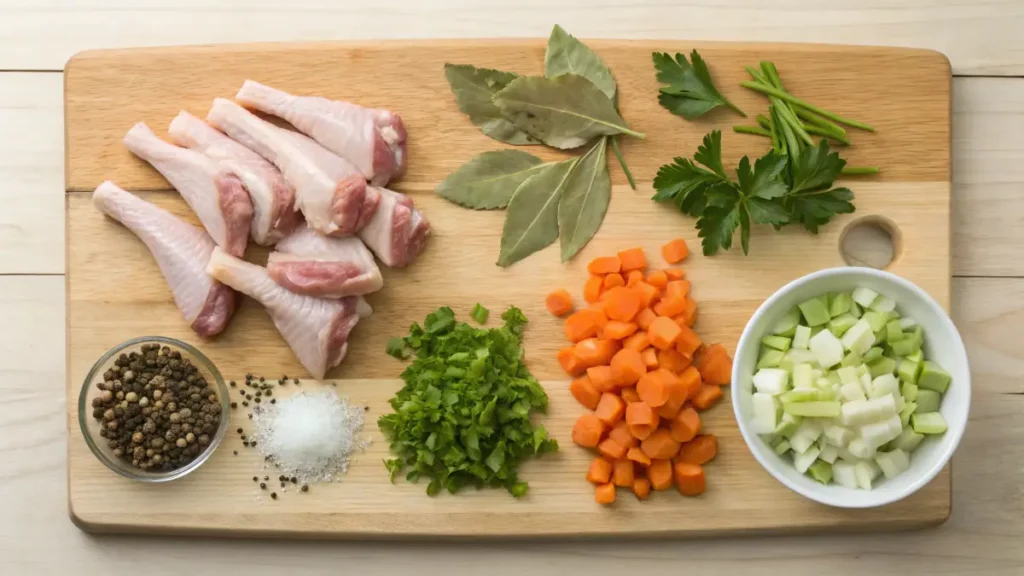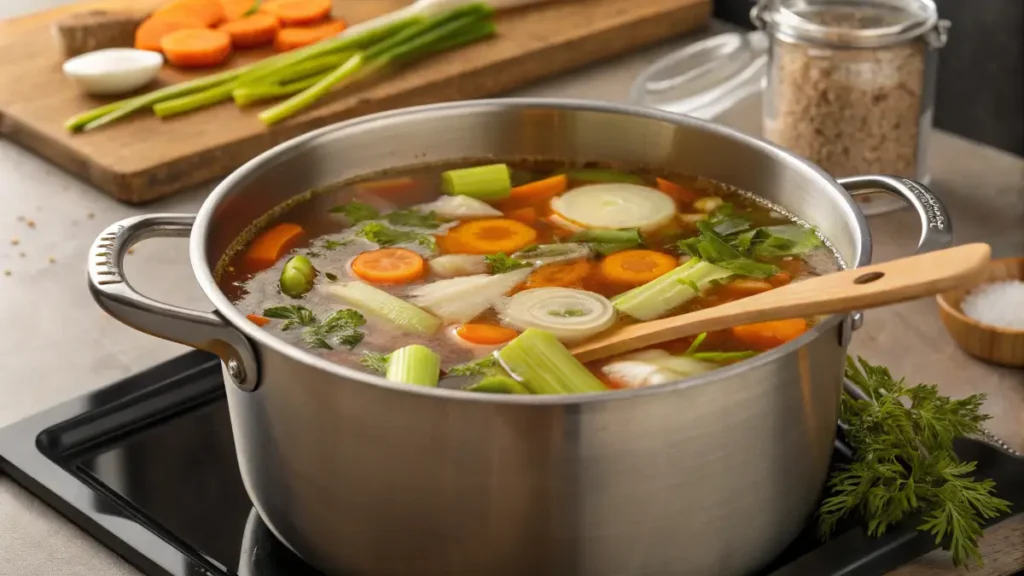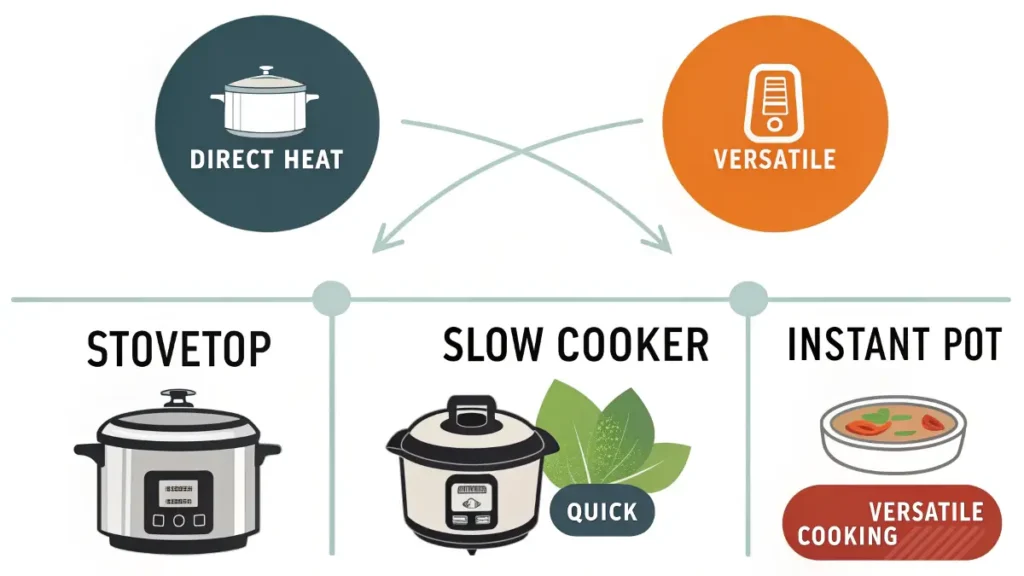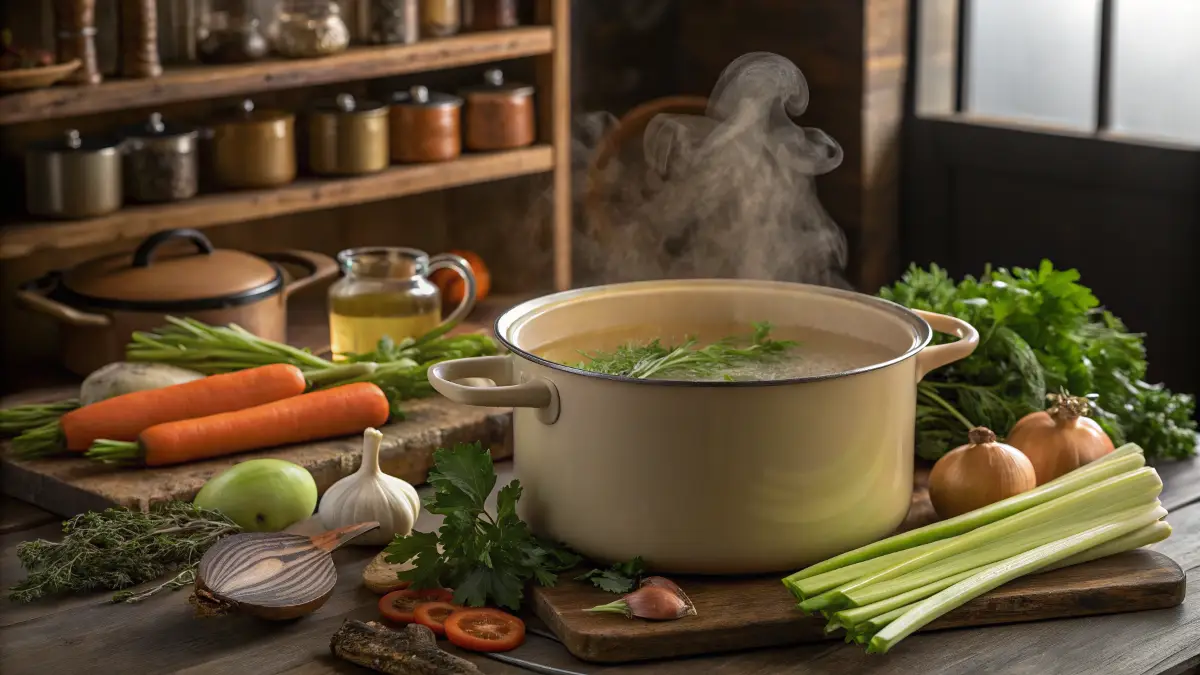Warm, nourishing, and packed with flavor, chicken bone broth recipe is a timeless staple in kitchens worldwide. In this guide, we’ll dive into everything you need to know about crafting the perfect chicken bone broth. From choosing the right ingredients to mastering the cooking process, this article will break it all down step-by-step. Whether you’re a beginner or an experienced home chef, this recipe will elevate your cooking and keep you coming back for more.
What is Chicken Bone Broth, and Why Make It?

What is Chicken Bone Broth?
Chicken bone broth is a nutrient-dense liquid made by simmering chicken bones with water, vegetables, and seasonings for an extended period. The process extracts flavors, gelatin, and essential nutrients from the bones, creating a rich, savory broth that’s a foundation for countless dishes.
Benefits of Chicken Bone Broth
- Packed with Nutrients: Collagen, amino acids, and minerals like calcium and magnesium are released during the cooking process, making this broth a natural powerhouse.
- Great for Digestion: The gelatin in chicken bone broth supports gut health by soothing the digestive lining.
- Versatile in the Kitchen: Use it as a base for soups, sauces, or even sip it as a warm beverage.
Essential Ingredients for a Flavorful Broth
- Chicken Bones: Use a mix of leftover carcasses, wings, or necks for the best results.
- Vegetables: Classic choices include carrots, celery, and onions for a balanced flavor.
- Herbs and Spices: Bay leaves, thyme, garlic, and peppercorns add depth.
- Acidic Element: A splash of apple cider vinegar helps draw nutrients from the bones.
- Water: Use filtered water to ensure a clean and pure broth.
Tips for Selecting the Right Ingredients
- Opt for organic, free-range chicken bones when possible for better flavor and nutrition.
- Avoid adding salt during cooking, as it’s best to season to taste at the end.
Step-by-Step Guide to Making Chicken Bone Broth
Preparing the Ingredients
- Gather the Bones: Use leftover bones from a roasted chicken or raw chicken parts, like wings, necks, or feet.
- Chop Vegetables: Dice carrots, celery, and onions into medium chunks for easy flavor extraction.
- Measure Water and Vinegar: Add just enough water to cover the bones, and include a tablespoon of apple cider vinegar to help release nutrients.
Cooking the Broth
- Combine Everything in a Pot: Place the bones, vegetables, herbs, and water into a large stockpot.
- Bring to a Simmer: Heat the pot on medium until it just starts to bubble, then lower the heat. Avoid boiling, as it can cloud the broth.
- Skim the Foam: During the first hour, skim off any foam or impurities that rise to the surface.
- Cook Low and Slow: Let the broth simmer for 12–24 hours. The longer it cooks, the richer the flavor.
Straining and Storing the Broth
- Strain the Liquid: Pour the broth through a fine mesh strainer into a clean container, discarding the solids.
- Cool It Down: Allow the broth to cool at room temperature before refrigerating.
- Storage Tips: Keep the broth in glass jars or freeze it in portions for long-term use.
Cooking Tips for Success
- Keep an eye on the water level during cooking; add more if needed to ensure the bones stay submerged.
- Don’t rush the process patience is key to extracting the most nutrients.
Creative Ways to Use Chicken Bone Broth
As a Base for Soups and Stews
One of the most common uses for chicken bone broth is as the base for hearty soups. Whether you’re making chicken noodle soup or a rich stew, the broth adds depth and nutrition to any recipe.
Sipping Broth for Health
Warm up a mug of broth, sprinkle in some salt, and sip it as a soothing drink. Many people enjoy sipping bone broth for its gut-healing properties.
Enhancing Rice, Grains, or Pasta
Replace plain water with chicken bone broth when cooking rice or quinoa to infuse it with extra flavor. You can also use it to cook pasta for a unique twist.
As a Sauce or Gravy Base
Use bone broth as a foundation for homemade sauces or gravies. It reduces beautifully and adds a savory richness to your dishes.
Incorporating in Daily Meals
From savory oatmeal to mashed potatoes, substituting water or milk with chicken bone broth in your recipes is a simple way to sneak in nutrients.
Nutritional Benefits of Chicken Bone Broth
Making a homemade chicken bone broth recipe is not just about flavor it’s also a nutritional powerhouse. Packed with essential nutrients, it’s a simple way to support your overall health.
Key Nutrients in Chicken Bone Broth
- Collagen: This protein supports healthy skin, hair, and joints.
- Amino Acids: Broth is rich in glycine, proline, and glutamine, which help with digestion and immunity.
- Minerals: Calcium, magnesium, and potassium are leached from the bones during the cooking process.
How Chicken Bone Broth Supports Your Health
- Boosts Joint Health: The collagen and gelatin in broth promote joint flexibility and reduce inflammation.
- Improves Digestion: Gelatin soothes the digestive lining and aids in nutrient absorption.
- Supports Immunity: The amino acids help strengthen the immune system, making it a great option during flu season.
- Aids Recovery: Broth is easy to digest and provides quick nutrition, making it ideal for post-illness recovery.
Why Homemade is Better
Store-bought broths often lack the depth of flavor and nutrients found in a homemade chicken bone broth recipe. By making it at home, you control the ingredients and ensure a healthier, tastier result.
Variations to Customize Your Chicken Bone Broth Recipe
Once you’ve mastered the basics, you can experiment with flavors and ingredients to create your own unique chicken bone broth recipe.
Adding Herbs and Spices
- For a Classic Flavor: Stick to thyme, bay leaves, and parsley.
- For a Bold Kick: Add ginger, turmeric, or chili flakes for an anti-inflammatory boost.
- For Earthy Notes: Include rosemary, sage, or fennel seeds.
Experimenting with Vegetables
- Root Vegetables: Try parsnips or turnips for a subtle sweetness.
- Umami Boost: Add dried mushrooms or a dash of soy sauce.
- Leftovers: Toss in vegetable scraps like celery tops or onion peels for zero waste.
Trying Different Proteins
While chicken bones are classic, you can swap them for turkey, duck, or even fish bones to create a variety of broths for different cuisines.
Enhancing for Specific Diets
- Low-Sodium Diets: Skip the salt entirely and season individual portions later.
- Keto-Friendly Broth: Add extra fats like butter or coconut oil to increase the calorie content.
- Vegan Alternative: Replace the chicken bones with roasted vegetables, kombu, and nutritional yeast for a plant-based version.
For more delicious recipe ideas, check out our Do Pineapple and Cheese Go Together? in Every tastes.
Common Mistakes to Avoid When Making Chicken Bone Broth

Even the best chicken bone broth recipe can fall short if a few common pitfalls aren’t avoided. Here’s how to sidestep the most frequent errors to ensure your broth is always perfect.
Skipping the Roasting Step
- Why It Matters: Roasting the chicken bones adds a depth of flavor and caramelized richness to the broth.
- How to Fix It: Always roast your bones in the oven at 400°F (200°C) for 20–30 minutes before simmering.
Using Too Much Water
- Why It Matters: Overfilling your pot dilutes the flavor and prevents the broth from becoming rich and savory.
- How to Fix It: Only use enough water to just cover the bones and ingredients.
Cooking at Too High a Temperature
- Why It Matters: Boiling the broth vigorously instead of simmering can result in a cloudy and greasy broth.
- How to Fix It: Keep the heat low and maintain a gentle simmer throughout the cooking process.
Forgetting to Skim Impurities
- Why It Matters: Foam and impurities that float to the top can affect the broth’s taste and texture.
- How to Fix It: Skim off the foam during the first 30–60 minutes of cooking for a cleaner, clearer broth.
Adding Salt Too Early
- Why It Matters: Salt can concentrate as the broth reduces, making the final result overly salty.
- How to Fix It: Wait until the broth is finished before adding salt to taste.
Storing and Reheating Your Chicken Bone Broth
Proper storage and reheating are essential to make the most out of your homemade chicken bone broth recipe. Here’s how to keep it fresh and flavorful.
Best Ways to Store Chicken Bone Broth
- In the Fridge: Store the broth in airtight containers or glass jars. It will stay fresh for up to 5–7 days.
- In the Freezer: For long-term storage, freeze the broth in portion-sized containers or ice cube trays. Frozen broth lasts up to six months.
- Label Your Containers: Always label with the date of preparation to track freshness.
Reheating Tips for Maximum Flavor
- Use Low Heat: Reheat the broth on the stovetop over low to medium heat to avoid overcooking.
- Add Fresh Herbs: Toss in fresh parsley, thyme, or a squeeze of lemon juice when reheating for an extra burst of flavor.
- Avoid the Microwave: While convenient, microwaving can unevenly heat the broth, affecting its consistency.
How to Spot If Broth Has Gone Bad
- Look for an unusual sour smell or mold on the surface.
- If the broth has a strange taste or appearance, it’s best to discard it.
Frequently Asked Questions About Chicken Bone Broth
It’s common to have questions when making a chicken bone broth recipe for the first time. Here, we answer some of the most frequently asked ones to help you create the perfect broth.
Yes, you can absolutely use raw chicken bones. However, roasting them first adds more depth to the flavor. If you’re short on time, raw bones still work well and will create a nutritious broth.
The ideal cooking time is 12–24 hours. Simmering for this long ensures that the nutrients, gelatin, and flavor are fully extracted. If using a pressure cooker, you can shorten the time to 2–3 hours.
This is actually a good sign! The gelatin comes from the breakdown of collagen in the bones, which is what makes the broth so healthy. Once reheated, it will return to a liquid state.
While possible, the second batch of broth will have less flavor and nutrients. It’s best to use fresh bones for every batch for the richest taste and benefits.
A cloudy broth is often caused by boiling instead of simmering. Keep the heat low and skim impurities during the cooking process to maintain clarity.
Final Tips for Perfecting Your Chicken Bone Broth Recipe
By now, you’ve learned how to make a fantastic chicken bone broth recipe, but a few final tips can help you take it to the next level.
Use High-Quality Ingredients
- Always choose fresh, organic chicken bones and vegetables when possible. Quality ingredients yield a better flavor and more nutrients.
- Filtered water is key to avoiding unwanted flavors or impurities in your broth.
Don’t Rush the Process
- Patience is crucial. Slow cooking allows the flavors to fully develop.
- If you’re in a hurry, use an Instant Pot to save time while still achieving a flavorful broth.
Keep it Versatile
- Store your broth in different portions, such as large containers for soups and small ice cube trays for sauces or quick flavor boosts.
- Add new ingredients like fresh herbs or citrus when reheating for variety in your meals.
Share and Enjoy
Chicken bone broth is meant to be shared. Whether you’re making it as a warm drink for friends or using it in family recipes, this broth is both comforting and nutritious.
Stovetop, Slow Cooker, or Instant Pot? Choosing the Best Method

One of the great things about a chicken bone broth recipe is its flexibility. You can prepare it using various methods depending on the time and tools you have available.
Stovetop Method
- Best for Traditional Cooking: The stovetop method is ideal if you prefer a hands-on approach.
- How to Do It: Use a large stockpot and simmer your broth for 12–24 hours. Keep the heat low and skim the surface occasionally.
- Pros: Easy to monitor and adjust. Great for large batches.
- Cons: Requires attention and uses more energy over long periods.
Slow Cooker Method
- Best for Set-It-and-Forget-It Cooking: A slow cooker is perfect if you don’t want to babysit the broth.
- How to Do It: Add all your ingredients, set the cooker to low, and let it simmer for 12–24 hours.
- Pros: Hands-off and energy-efficient. Ideal for overnight cooking.
- Cons: Takes up counter space and may not get as hot as a stovetop.
Instant Pot Method
- Best for Quick Cooking: When you’re short on time, the Instant Pot is your go-to option.
- How to Do It: Use the “Soup” or “Pressure Cook” setting and cook for 2–3 hours. Let the pressure release naturally for best results.
- Pros: Saves time while still extracting flavors and nutrients.
- Cons: Smaller batches compared to other methods.
Which Method is Right for You?
Choose the method that best suits your lifestyle. If you love the hands-on approach, go for the stovetop. Prefer convenience? A slow cooker or Instant Pot is the way to go.
How to Flavor Your Broth for Different Cuisines
A basic chicken bone broth recipe is versatile, but you can enhance it to suit various cuisines. Here are some ideas to infuse global flavors into your broth.
Asian-Inspired Broth
- Add These Ingredients: Fresh ginger, garlic, star anise, soy sauce, and a dash of sesame oil.
- Use It For: Ramen bowls, wonton soup, or as a base for stir-fried dishes.
Mediterranean-Style Broth
- Add These Ingredients: Rosemary, thyme, oregano, lemon zest, and olive oil.
- Use It For: Lentil soup, chicken stew, or pasta sauces.
Mexican-Style Broth
- Add These Ingredients: Dried chilies, cumin, coriander, cilantro, and lime juice.
- Use It For: Tortilla soup, pozole, or as a flavorful base for rice.
Indian-Inspired Broth
- Add These Ingredients: Turmeric, garam masala, cinnamon sticks, and fresh curry leaves.
- Use It For: Dal, curry bases, or spiced vegetable stews.
Tips for Balancing Flavors
- Always taste as you go and adjust seasonings.
- Keep a light hand with strong flavors so they don’t overpower the natural taste of the broth.
Conclusion: A Timeless Recipe for Health and Flavor
Crafting a chicken bone broth recipe is more than just a cooking project it’s a tradition rooted in simplicity, nourishment, and versatility. From its rich nutritional benefits to its endless culinary applications, bone broth is a staple every home cook should master. Whether you’re sipping it on a chilly evening, using it to elevate your soups and sauces, or freezing it for later, this recipe is your gateway to countless delicious and healthy meals.
Remember, the secret lies in patience, high-quality ingredients, and experimenting with flavors to suit your tastes. With the tips and variations outlined in this guide, you’ll be able to create a broth that’s not only rich in flavor but also brimming with health benefits.
So gather your bones, grab your pot, and let the simmering begin your perfect chicken bone broth awaits!

